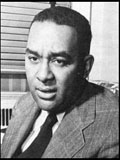|
● Early
Fiction
● Transcendentalists
● Power
of Imagination
● New
Visions of America
● Reform
and Liberation
● Regionalism
● A
New Wave
● Sympathetic
Views
● Rebellious Spirit
● The
Modernists
● The Lost Generation
● Harlem Renaissance
● New
Drama
● Depression,
Realism and Escapism
● Postwar Voices
and the "Beat Generation"
● New American
Voices
Postwar Voices and the"Beat Generation"
 |
|
Richard Wright
|
|
|
| Ralph
Ellison |
| |
| James
Baldwin |
 The
new receptivity
of American society to a diversity
of voices incorporated black writers and black protest into the
mainstream of American literature. Richard Wright's (1908-1960)
disturbing novel Native Son, published in 1940, revealed
a new black hero, whose character had been warped
by this violent and cruel society. The hero of Ralph
Ellison's (1914-1994) Invisible Man (1952), is also
driven underground by the values of white society. James
Baldwin's characteristic themes, hatred of racism and celebration
of sexuality, were expressed in novels like Go Tell It on the
Mountain (1953) and in essays like Nobody Knows My Name
(1961), The Fire Next Time (1963). The
new receptivity
of American society to a diversity
of voices incorporated black writers and black protest into the
mainstream of American literature. Richard Wright's (1908-1960)
disturbing novel Native Son, published in 1940, revealed
a new black hero, whose character had been warped
by this violent and cruel society. The hero of Ralph
Ellison's (1914-1994) Invisible Man (1952), is also
driven underground by the values of white society. James
Baldwin's characteristic themes, hatred of racism and celebration
of sexuality, were expressed in novels like Go Tell It on the
Mountain (1953) and in essays like Nobody Knows My Name
(1961), The Fire Next Time (1963).
 American
Jews also began to raise their literary voices at this time. Writers
such as Saul
Bellow (The Adventures of Augie March, 1953), Bernard
Malamud (The Assistant, 1957), and Philip Roth (Good-bye,
Columbus,1959) not only focused upon Jewish characters and social
questions, but brought a distinctively Jewish sense of humor to
their novels. Their prose often carried echoes
of Yiddish,
the language used by European Jews, which had helped preserve Jewish
culture, isolated but intact,
until the early 20th century. Another Jewish writer, Isaac Bashevis
Singer, who was born in Poland but had emigrated to the United States
in 1935, continued to write in Yiddish, though his stories were
quickly translated into English and became part of the national
literature. Both Singer and Bellow won the Nobel Prize for Literature. American
Jews also began to raise their literary voices at this time. Writers
such as Saul
Bellow (The Adventures of Augie March, 1953), Bernard
Malamud (The Assistant, 1957), and Philip Roth (Good-bye,
Columbus,1959) not only focused upon Jewish characters and social
questions, but brought a distinctively Jewish sense of humor to
their novels. Their prose often carried echoes
of Yiddish,
the language used by European Jews, which had helped preserve Jewish
culture, isolated but intact,
until the early 20th century. Another Jewish writer, Isaac Bashevis
Singer, who was born in Poland but had emigrated to the United States
in 1935, continued to write in Yiddish, though his stories were
quickly translated into English and became part of the national
literature. Both Singer and Bellow won the Nobel Prize for Literature.
 In
the theater, Tennessee
Williams (1911-1983), beginning with The Glass Menagerie
(1945), expressed his southern heritage
in poetic yet sensational plays, usually about a sensitive woman
trapped in an insensitive environment. Street Car Named Desire
is considered his best play. Arthur Miller portrayed the common
man pressured by society; his greatest play, Death of a Salesman
(1947), turned a second-rate traveling salesman, Willy Loman, into
a quasi-tragic
hero. When this play was staged in china, it was a big success. In
the theater, Tennessee
Williams (1911-1983), beginning with The Glass Menagerie
(1945), expressed his southern heritage
in poetic yet sensational plays, usually about a sensitive woman
trapped in an insensitive environment. Street Car Named Desire
is considered his best play. Arthur Miller portrayed the common
man pressured by society; his greatest play, Death of a Salesman
(1947), turned a second-rate traveling salesman, Willy Loman, into
a quasi-tragic
hero. When this play was staged in china, it was a big success.
 The
San Francisco writers were part of a large group called the "Beat
Generation," a name that referred simultaneously
to the rhythm of jazz music, to their sense that society was worn
out, and to their interest in new forms of experience, through drugs,
alcohol or Eastern mysticism.
Poet Allen Ginsberg's
Howl (1956) set for them a tone of social protest and visionary
ecstasy,
in elaborate
language reminiscent
of Whitman. The
San Francisco writers were part of a large group called the "Beat
Generation," a name that referred simultaneously
to the rhythm of jazz music, to their sense that society was worn
out, and to their interest in new forms of experience, through drugs,
alcohol or Eastern mysticism.
Poet Allen Ginsberg's
Howl (1956) set for them a tone of social protest and visionary
ecstasy,
in elaborate
language reminiscent
of Whitman.
 While
other writers did not espouse
the life style of the Beats, they also viewed the world on a comic,
absurd light. In J. D. Salinger's The Catcher in the Rye
(1951), a sardonic
teenage boy resists the hypocrisies
of adult society. Funny as the novel is, there is something tragic
in the boy's hopelessness about his world. While
other writers did not espouse
the life style of the Beats, they also viewed the world on a comic,
absurd light. In J. D. Salinger's The Catcher in the Rye
(1951), a sardonic
teenage boy resists the hypocrisies
of adult society. Funny as the novel is, there is something tragic
in the boy's hopelessness about his world.
Previous Page Next
Page
|

